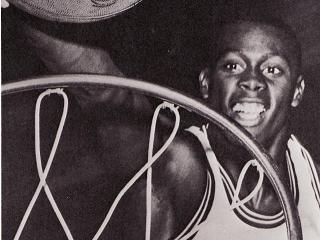James Rada
Emmitsburg Dispatch
(1/3) Editor’s Note: This is the
fourth in a series of articles The Dispatch will be featuring to highlight the
year-long celebration of Mount St. Mary’s University’s bicentennial.
When Mount St. Mary’s basketball coach Jim Phelan traveled to
Philadelphia in 1965, he believed he was going to watch potential recruits for
his team not break down racial barriers.
“We had won a national championship in 1962 and up until that
point, we had no black players,” Phelan said. “But black players were starting
to play the game more and it was time to recruit them.”
The athletic director had not problem with recruiting black
players, but he wasn’t sure how much a small, country college would interest
them.
Phelan took went to see John Baum and Bob Sutor play in a game
in Philadelphia, but he came back impressed by a high school dropout name Fred
Carter, who had played in the same game. The 6 foot 3 inch tall Carter had gone
back to school and was working hard for his high school degree.

Phelan asked Carter if he would be interested in attending
Mount St. Mary’s. “He said, ‘If you can get me in, I’ll come,” just like that,”
Phelan said.
Carter visited the campus and signed on. In the fall of 1965,
he took a train to Baltimore where Phelan picked him up to drive back to
Emmitsburg.
“I remember coming through Taneytown and Westminster and seeing
grass, cows or horses,” Carter said during a recent visit to the campus to
retire his jersey number. “It’s something that always stuck with me because at
the time I had never seen that.”
During the drive to Emmitsburg, Carter asked Phelan how many
other African-American students attended the Mount. Phelan looked at him and
said, “Fred, look in the rear view mirror and you’ll see how many we’ve got,”
Phelan said.
Under Phelan’s coaching, Carter averaged 21.9 points and 11
rebounds in his 84 games at the college. He scored 1,840 points while playing
at the Mount.
Perhaps more importantly, he became the first African-American
resident student at the college, breaking down racial barriers at a college
that had owned slave more than a century before.
Phelan said he sat down with Carter to talk to him about being
the first black resident. He warned Carter that that the girls from St. Joseph
College were going to come after him and want to date him because he was
African American. Phelan told him, “Don’t let them use you.”
Phelan doesn’t recall any major problems, other than catcalls,
during games except for a game at Randolph Macon College where two student
jumped on Carter from the bleachers as he was walking off the floor. His
teammates quickly came to his aid, though.
“Fred dominated things for four years,” Phelan said. “He
basically integrated the (Mason Dixon) league.”
Because of Carter’s success at the Mount, the following year, the college had
four African American players. African Americans started appearing on other
teams in the Mason Dixon Conference as well.
“The Mount meant so much to me in so many ways in terms of
growth and development from a boy to a man,” Carter said in an article in the
Frederick News-Post. “It broadened me and my perspective.”
Under Phelan’s coaching, Carter averaged 21.9 points and 11
rebounds in his 84 games. He scored a 1,840 points while playing for the Mount.
More importantly, he broke down racial barriers at a college
that had owned slaves more than a century before. Carter became the first
African-American resident student at the Mount, earning the respect of his
peers.
The Baltimore Bullets drafted Carter in the third round of the
1969 National Basketball Association draft and Carter went on to play eight
seasons of professional basketball with the Bullets, Philadelphia 76ers and
Milwaukee Bucks. He later went on to coach the Bucks and the Mount Women’s
Basketball Team.
Mount St. Mary’s retired his 33 jersey in December during a halftime of a game
against Loyola. Carter spoke during the ceremony before a crowd of 2,109.
"I love the people here,” Carter said as the crowd chanted his
nickname, “Mad Dog.”
Read other stories on Mt. St. Mary